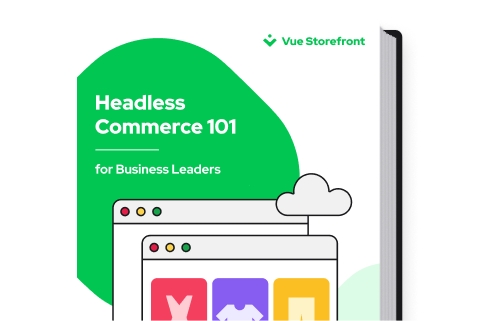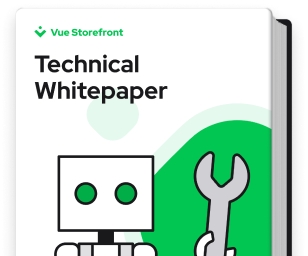Explore by Category:
Headless Commerce
How to Implement Headless Commerce: A Short Explanation
According to Forbes, headless technology received about $1.65 billion in financing between 2020 and 2021. This figure will rise as with businesses expanding and modernizing each day, the demand for headless commerce grows more pressing. This article will teach you how to implement headless commerce and choose the best headless solution providers for your online store.
Components of a full headless commerce stack
Headless commerce decouples the frontend and backend layer of the system to let eCommerce businesses compose their tech stack out of best-of-breed solutions. A standard headless commerce architecture entails following elements:
Frontend as a Service
Frontend as a Service is a frontend solution for composable commerce that allows you to build and customize an immersive, innovative frontend for your eCommerce website with one tool in one place. You can use Frontend as a Service to produce optimized, well-tested, performant, and consumer-centric interfaces without spending months developing a custom-built frontend.
eCommerce platform
An eCommerce platform is a modern, efficient commerce engine working separately from the frontend layer. The communication between the two layers occurs via API, which makes the process swift and smooth. Headless commerce platforms use APIs for data orchestration, and as a result, each implementation proceeds faster, and the whole system runs more responsively.
Headless CMS
A headless CMS (Content Management System) allows the storage and organization of content independently from the entire eCommerce tech stack. It enables the delivery of content to multiple channels and devices, allowing for smooth omnichannel sales.
Search providers
Search and discovery tools efficiently deliver rich product and content-based experiences on every device and channel.
Payment providers
API-hosted payment gateways can be integrated within the headless stack to provide a UI for the checkout and payment process through integrations with a payment provider.
API in headless commerce
API in headless commerce is a connection to one communication layer, standardized across all the technologies to connect them with more flexibility and speed. It is a vital component of the MACH approach to future-proof enterprise technology and propels current and future digital experiences. Developers who know how to play with APIs can learn one basic principle and use this language (APIs) to connect things in a standardized manner quickly.
The above mentioned solutions are standard elements of a headless commerce stack. As the industry grows and gains popularity due to its efficiency, more headless vendors are joining the market daily.
How to choose the right headless commerce vendor
When you're ready to prioritize speed-to-market, user experience, and the need for continual innovation, it's time to move from all-in-one solution to modern headless technology .
Maybe you’ve already identified the need to migrate, but you are suffering from ‘vendor fatigue’ in your journey to identify the first step towards a headless commerce stack. You might be exhausted from all the headless sales reps banging down your email door, all promising the same benefits and user-friendly solutions.
If you are wondering how to implement headless commerce smoothly, consult the right eCommerce migration path and the choice of headless commerce solutions, with solution integrators experienced with similar implementations. Visit our partner agencies directory to find the right solution integrator.
Headless commerce is becoming more sophisticated and competitive as more and more vendors enter the market. Knowing which vendors to choose can be challenging, so you must understand what’s out there and which platforms will work with your business needs.
Here's a list of criteria to think about while focusing your options:
The simplicity of the integration. How simple is it to integrate your current systems? Does it allow for customization?
Security. What level of protection is provided, and how does the platform satisfy your requirements?
Scalability. What are the options to secure your system for future growth?
Support. How much assistance do you receive from the solution’s provider?
Pricing. What is the pricing model? Is it an open-source or enterprise solution? What’s included in the fee?
If you are looking for recommended headless solutions, visit our technology partners directory .
How to implement headless commerce
All you need is a straightforward migration path to a headless system that will improve your customer experience, get you back into the top 10 on the SERPs, and show your hand at rocking the company’s revenue again. Although your business is unique, there are tried and tested solutions that eCommerce businesses have adopted when migrating from legacy systems to headless.
Since we already briefly introduced the elements of a standard headless commerce stack, let’s discuss the two methods for implementing headless commerce:
Full replatforming, which requires exchanging the entire eCommerce system to a new headless commerce stack.
Step-by-step migration, where you follow a phased process of systematically upgrading your store while maintaining the existing eCommerce platform.
Let’s take a closer look at each method separately.
Full replatforming
A full replatforming usually takes place when a store outgrows its current platform's capabilities, or the existing legacy system is no longer supported.
Unfortunately, replatforming activities might turn out complex, time-consuming and expensive as they require exchanging the entire tech stack at the same time.
The process of the full replatforming goes as follows:
You create a whole new headless stack on the side (frontend, API orchestration layer, CMS, eCommerce platform, hosting), like you would build with LEGO blocks.
Once the new headless stack is assembled, you complete all necessary testing.
After testing, you move all the data to the new system and go live on it.
You can split replatforming projects into several distinct steps:
Comprehensive project planning
Vendor selection
Selecting your SI partner
Discovery phase
Development and customizations
Going live
Continuous deployment
Each stage has its own set of prerequisites and challenges. There are numerous stakeholders to consider, which increases the difficulty of managing expectations vs. reality. Be prepared for this at each step.
Understandably, many decision-makers believe every eCommerce digital transformation journey must start with the eCommerce platform, which requires full replatforming. They’ve always viewed it as the backbone of the eCommerce business, with all other functionalities having to flow from it.
But, your frontend is the HEAD (brain) of a headless stack where all other features and functionality must collaborate to deliver the best UX for your customers. Your entire customer journey takes place in the frontend, and this is where your focus must be at the start of your migration strategy to ensure world class customer experiences.
This is why regardless if you decide on a full replatforming or a gradual migration, you need to start with the frontend.
Step-by-step implementation of headless commerce
Gradual implementation of headless commerce is a more cost-effective choice for companies which prioritize web performance and customer experience. If you are hesitant to ditch your current software suite but still want to reap the benefits of headless commerce , this is the way to go.
As a fast-track and customer-focused path to headless commerce, a step-by-step process begins with exchanging the frontend while maintaining the current backend core of the system in place.
The process of gradual migration to headless goes as follows:
You add a new performant frontend, like Alokai, to your existing all-in-one software suite
You complete testing the integration before going live
When it’s ready and the company metrics have improved, you can systematically add the rest of your headless components and replatform at your own pace.
A gradual approach to headless migration allows you to start at the frontend (UI), where you can quickly improve metrics for web performance, SEO and customer experience, which translate into higher conversions and revenue. With ready integrations offered by Alokai you will be able to continue with your current eCommerce suite while optimizing and customizing your storefront.
Read more about headless commerce SEO .
Once all metrics are improved, you can start loosening up the rest of your stack by adding other 3rd party tools and and run re-platforming to a new headless commerce platform if needed.
There are a few key benefits of a step-by-step migration:
It minimizes risk by allowing for a gradual transition to the new architecture.
It avoids the need for a complete rewrite, which can be costly and time-consuming.
It allows you to incrementally improve the overall design of your system.
It makes it easier to migrate data and users to the new system.
Start with the frontend
Starting your headless commerce journey with the frontend provides a fast and cost-efficient alternative to full replatforming. Instead of changing the entire engine, you add a performant, mobile-first frontend to your current eCommerce platform.
There are numerous benefits of starting your headless transformation with the frontend:
- Accelerated time-to-market, which brings profits from day one
- Lower TCO
- Improved web performance
- Supercharged customer experience
- Increased conversion rates and ROI
- Unlocked possibility to future-proof and scale easily
Learn more about why you should think frontend-first: 5 reasons to start with the frontend
Start with Alokai
Because frontend is where the entire customer journey happens, to improve customer experience, increase conversions and drive sales, you need a fast and mobile-friendly presentation layer.
However, building a custom frontend from scratch is a long and daunting process. You need to take care of multiple aspects and perform plenty of repetitive tasks to deliver a well-performing, mobile-friendly storefront. Fortunately, there is a cost-effective way to speed up time to market and ensure best-class shopping experience: starting your headless transformation with Frontend as a Service like Alokai.
Thanks to ready Alokai integrations with solutions like SAP Commerce Cloud, BigCommerce or Magento, you don’t need to fully replatform to reap the benefits of headless commerce. Add a FEaaS-based frontend on top of your current platform to gain flexibility, faster page loads and improved customer experience.
Download our whitepaper and learn how to implement headless commerce with Alokai
Share:
Share:
More in Headless Commerce
Frequently asked questions
Ready to dive in? Schedule a demo
Get a live, personalised demo with one of our awesome product specialists.























